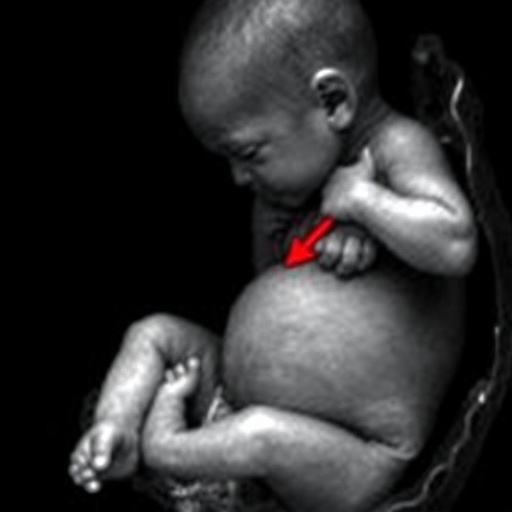Gastric devascularization is an intricate surgical procedure, typically reserved for extreme circumstances involving gastrointestinal bleeding, especially in neonates. Such procedures are not only technically challenging but also require a comprehensive understanding of pediatric anatomy and surgical techniques. In a recent case report published in BMC Pediatrics, Liu et al. delve into a particularly poignant case of a neonate suffering from massive upper gastrointestinal bleeding, which led them to perform gastric devascularization. This procedure emerged as a life-saving intervention amidst considerable risk, making it a critical topic within pediatric medical discussions.
Neonates, characterized by their fragility and distinct physiology, pose unique challenges when it comes to surgical intervention. These patients often present under conditions that result in rapid deterioration, emphasizing the need for immediate and effective treatment strategies. The case reported by Liu and colleagues involves a newborn who exhibited severe upper GI bleeding—a situation that can escalate quickly if not addressed promptly. The swift decision to engage in gastric devascularization reflects not only the severity of the clinical presentation but also the surgical team’s expertise in executing such complex operations.
Massive upper GI bleeding in neonates can stem from a variety of underlying causes. In many instances, conditions such as congenital anomalies, vascular malformations, or even acquired disorders can contribute to this perilous situation. Liu et al. highlighted the need for a thorough diagnostic workup to ascertain the root cause of the bleeding, emphasizing that the complexity of the underlying pathology necessitates a tailored surgical approach. Hence, a well-coordinated effort between surgical teams and pediatric specialists is critical in managing such delicate cases effectively.
The intricate nuances of gastric devascularization, especially in pediatric populations, cannot be overstated. The procedure involves significant alterations to the vascular supply of the stomach, requiring a detailed understanding of the intricate blood supply and its anatomical variations. Liu and team meticulously documented the surgical steps taken, showcasing their methodological approach to mitigating risks during the procedure. The delicate excision of vascular components must be conducted with precision to prevent unintended injury to adjacent structures, which could complicate recovery and lead to further complications.
Following the surgery, the recovery process for neonates remains a focal point of consideration. Liu et al. reported on the post-operative trajectory of the infant, underscoring the importance of close monitoring in the intensive care unit. Neonates may exhibit physiological responses that differ significantly from older children or adults, amplifying the challenges healthcare providers face during recovery. Their observations illustrated the necessity for vigilant monitoring and intervention to handle potential complications such as infection, bleeding, or impaired gastric function, which can adversely affect a neonate’s recovery trajectory.
Liu and colleagues also took the time to engage with the broader literature regarding gastric devascularization procedures in neonates, synthesizing various insights and findings to contextualize their case report. This review of existing literature not only underscores the rarity of such surgeries in this demographic but also provides a roadmap for future practitioners seeking guidance when faced with similar clinical scenarios. With advancements in surgical techniques and perioperative care, there lies considerable potential for improving outcomes in such delicate interventions.
Interestingly, the implications of this case extend beyond the surgical interventions themselves. Liu et al. provided a comprehensive discussion on the psychological and emotional ramifications for families encountering such spine-tingling situations. The stress of caring for a newborn undergoing major surgery can be overwhelming, and the authors emphasized the importance of psychological support systems for both patients and families during the treatment process. This holistic approach is paramount in ensuring that emotional aspects are addressed, thereby enriching the overall care experience for families facing daunting challenges.
As part of their systematic review, Liu and colleagues shed light on potential future research directions. Given the intricacies involved in gastric devascularization and its implications for neonatal care, there lies a rich avenue for further investigation. Potential studies could focus on developing improved techniques or technologies that could enhance surgical precision and outcomes, thereby mitigating some of the risks inherent in these delicate procedures.
Ultimately, the surgical community stands to learn and grow with each case, and the documentation of gastric devascularization in neonates, as outlined by Liu and colleagues, represents a vital contribution to the field of pediatric surgery. The sharing of such experiences can help fine-tune approaches and save lives, underscoring the critical role of collaboration among medical professionals. There’s a collective responsibility to continue to explore, document, and share these complexities, as this is key to improving care standards for the most vulnerable patient groups.
In conclusion, the case study presented by Liu et al. serves as both a sobering reminder of the challenges faced in pediatric surgery and an uplifting testament to what is achievable with skilled surgical intervention. Their contribution not only enriches the existing body of knowledge surrounding gastric devascularization in neonates but acts as a beacon of hope for practitioners navigating the tumultuous waters of pediatric gastrointestinal emergencies. Each successful intervention continues to pave the way for healing and recovery, illustrating the profound impact medical professionals can have on the lives of their youngest patients.
Scientific exploration of complex cases such as these is imperative as it shapes future practices and refines surgical techniques. The collaborative nature of pediatric care exemplified in this case reinforces the notion that interprofessional dialogue and cooperation are critical in optimizing outcomes. Continued efforts in research and education surrounding such unique cases ensure that advancements in medical technology and practices remain at the forefront, promoting a future where similar challenges can be met with even greater success.
With the ongoing evolution in medical science, the possibility of developing less invasive methods and improved surgical strategies remains an exciting frontier. As we reflect upon the poignant narrative presented in Liu et al.’s case report, it becomes evident that the journey toward advancing pediatric surgical intervention, particularly in life-threatening situations, is a testament to human resilience and medical ingenuity.
The pursuit of excellence in surgical care for neonates underscores the importance of knowledge sharing and community support. Each successful case strengthens a network of practitioners who can contribute to a more profound understanding of neonatal care, paving the way for safer and more effective surgical outcomes for infants in need.
Strengthened by scientific inquiry and a commitment to improving care, the realm of pediatric surgery will undoubtedly continue to flourish, underpinned by promising innovations and unwavering dedication to the health of the youngest among us.
Subject of Research: Gastric devascularization in neonates with massive upper GI bleeding
Article Title: Gastric devascularization in a neonate with massive upper GI bleeding: a case report and literature review
Article References:
Liu, X., Han, Y., Huang, M. et al. Gastric devascularization in a neonate with massive upper GI bleeding: a case report and literature review.
BMC Pediatr 25, 801 (2025). https://doi.org/10.1186/s12887-025-06217-z
Image Credits: AI Generated
DOI: 10.1186/s12887-025-06217-z
Keywords: gastric devascularization, neonates, gastrointestinal bleeding, pediatric surgery, case report
Tags: case study in pediatric surgerychallenges of neonatal surgerycomplex surgical procedures in pediatricscongenital anomalies in infantsemergency treatment for GI bleedinglife-saving interventions for neonatesmassive upper gastrointestinal bleeding in infantsneonate gastric devascularizationpediatric anatomy understandingpediatric surgical techniquessurgical risks in neonates





